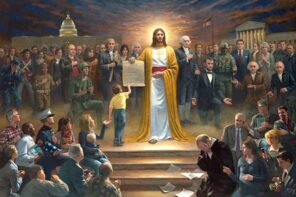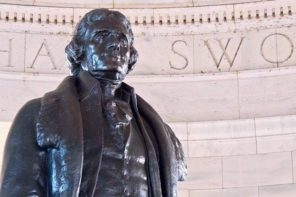During the controversy surrounding the selection of a design for the Martin Luther King Jr. Memorial, there was one unofficial proposal so quietly audacious that even the man who put it forward, art historian Kirk Savage, had to admit that it “would never happen.” Savage believed, as he told the New York Times‘ Shaila Dewan in 2008, that the most fitting memorial to Dr. King would have been a “life-size statue of him, placed on the steps of the Lincoln Memorial, where he stood when he delivered his most famous oration.” The actual memorial, as designed by Chinese sculptor Lei Yixin, conveys a rather different affect.
Instead of Savage’s seemingly unassuming commemoration, visitors to the King memorial are confronted with a thirty-foot tall relief statue of the minister and civil rights leader carved from white Chinese granite, emerging as if incomplete from 1,600 tons of rock. Criticism dogged the project from the moment Yixin’s design was revealed, centering around the fact that the chosen artist wasn’t African American, that the Chinese granite was mined using exploited labor, and, not least of which, that King was made to appear “confrontational” or “arrogant.” Even the U.S. Commission of Fine Arts noted that Yixin’s Social Realist aesthetic recalled a “genre of political sculpture that has recently been pulled down in other countries,” before ultimately voting to approve the design.
Lost in the static was Savage’s modest proposal, easy to dismiss because its lack of expense may have signified to some a lack of respect. Nothing could be more inaccurate, however, and in the comparison between Yixin’s final design and Savage’s thought experiment is a helpful parable about the ways in which this nation has commemorated King compared to the actual radical legacy the martyred preacher represented.
From one perspective, the final choice could be seen as indicative that the United States was giving final due respect to the legacy of one of our most important human rights activists, a theologian instrumental in not just adapting his faith into a doctrine of emancipation, but whose rhetoric helped to encapsulate the full covenantal potential of America. As only the fourth non-president with a memorial on the National Mall, and the first African American, King’s statue would be rightly seen as a proud moment whereby the nation recognized historical injustices, and honored the seminal figure who fought against those injustices.
However, from another vantage point the memorial can be seen as inadvertently eliminating that which was gloriously radical, subversive, revolutionary, emancipatory, and liberatory about King, transforming him into another Founding Father figure in our national civil religion. An excuse for a three-day weekend rather than a tribute to America’s preeminent theorist of both racial and economic justice. To only remember the King who helped organize and headline 1963’s March on Washington, but not the King who led 1968’s Poor Person’s Campaign, is to only acknowledge half of the minister.
To rightly celebrate the figure who spoke in the “I Have a Dream” speech of the “architects of our republic [who] wrote the magnificent words of the Constitution and the Declaration of Independence,” while ignoring the man who, with justified prophetic fury, could write in 1968 that American imperialism in Vietnam constituted “an unjust, evil, and futile war,” is to not fully respect the enormity of King’s vision.
Conservatives, like Jesse Helms and the since-sainted John McCain, who despicably opposed the institution of a Martin Luther King Day holiday when it was first proposed in 1979, did so in part precisely because of the minister’s prophetic, radical urgency. Ironically, both the holiday and the memorial have inadvertently served to sanitize King’s radicalism—the very thing so urgently needed in our current political moment. As philosopher Cornel West wrote in a 2018 opinion piece in The Guardian, “we should be highly suspicious of those who sing his praises yet refuse to pay the cost of embodying King’s strong indictment of the US empire, capitalism and racism in their own lives.”
Or, as Jeanne Theoharis wrote on RD, “A story that should have reflected the immense injustices at the nation’s core and the enormous lengths people had gone to attack them had become a flattering mirror. The popular history of the civil rights movement now served as testament to the power of American democracy.”
Incidentally, the final literal cost of the memorial designed by Yixin was $120 million, while the proposal from Savage wouldn’t have cost much more than a few thousand in bronze casting. Savage’s statue would seem as modest as something placed in a town square or on a college campus—and thus, to detractors, not fitting to the legacy of King himself. I’d suggest that the far more appropriate proposal was actually Savage’s, and ironically it’s for that reason entirely that the art historian is correct that it would have never been considered.
Savage writes of the Lincoln Memorial (to which King’s memorial would have been both literally and physically connected in his proposal), “that interplay in the landscape ceases to be a mere symbol of America and becomes an actor in the nation’s drama. Not only do the monuments of Washington [DC] retell the story of the nation but… they change national history itself.” Such is the case with King’s own story concerning the Lincoln Memorial, where he delivered his “I Have a Dream” speech in 1963, which is part of why placing a representation of him on the steps would have been so radical.
Savage’s proposed memorial would have been an acknowledgement that Lincoln’s vision was incomplete, that the task of emancipation was (and is) ongoing, and that as a nation we’re willing to understand this continuing task. It would have revised a beloved monument by including within it the central actor of that memorial’s most important event—the 1963 March on Washington for Jobs and Freedom. Such would be a fuller encapsulation of King’s significance than the monumental Social Realism of the ultimate memorial. A quieter yet far more powerful statement about the leader as a critic and reviser of American ideals.





